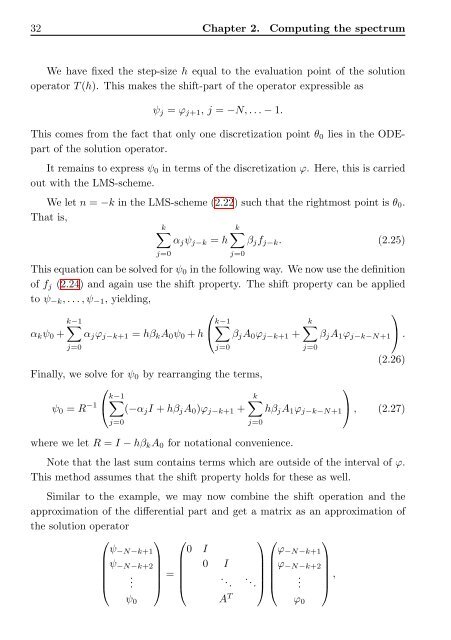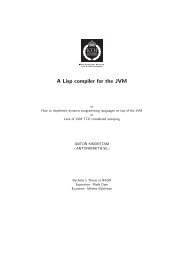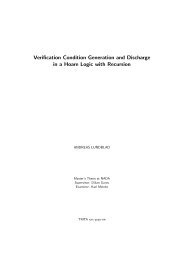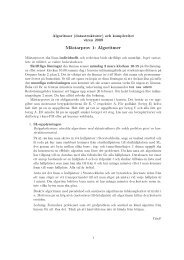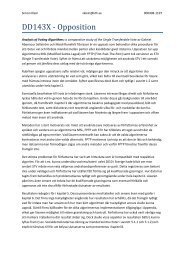The spectrum of delay-differential equations: numerical methods - KTH
The spectrum of delay-differential equations: numerical methods - KTH
The spectrum of delay-differential equations: numerical methods - KTH
Create successful ePaper yourself
Turn your PDF publications into a flip-book with our unique Google optimized e-Paper software.
32 Chapter 2. Computing the <strong>spectrum</strong><br />
We have fixed the step-size h equal to the evaluation point <strong>of</strong> the solution<br />
operator T (h). This makes the shift-part <strong>of</strong> the operator expressible as<br />
ψj = ϕj+1, j = −N, . . . − 1.<br />
This comes from the fact that only one discretization point θ0 lies in the ODEpart<br />
<strong>of</strong> the solution operator.<br />
It remains to express ψ0 in terms <strong>of</strong> the discretization ϕ. Here, this is carried<br />
out with the LMS-scheme.<br />
We let n = −k in the LMS-scheme (2.22) such that the rightmost point is θ0.<br />
That is,<br />
k�<br />
k�<br />
αjψj−k = h βjfj−k. (2.25)<br />
j=0<br />
This equation can be solved for ψ0 in the following way. We now use the definition<br />
<strong>of</strong> fj (2.24) and again use the shift property. <strong>The</strong> shift property can be applied<br />
j=0<br />
to ψ−k, . . . , ψ−1, yielding,<br />
⎛<br />
k−1 �<br />
k−1 �<br />
αkψ0 + αjϕj−k+1 = hβkA0ψ0 + h ⎝ βjA0ϕj−k+1 +<br />
j=0<br />
j=0<br />
Finally, we solve for ψ0 by rearranging the terms,<br />
ψ0 = R −1<br />
⎛<br />
k−1 �<br />
k�<br />
⎝ (−αjI + hβjA0)ϕj−k+1 +<br />
j=0<br />
j=0<br />
where we let R = I − hβkA0 for notational convenience.<br />
k�<br />
j=0<br />
hβjA1ϕj−k−N+1<br />
βjA1ϕj−k−N+1<br />
⎞<br />
⎞<br />
⎠ .<br />
(2.26)<br />
⎠ , (2.27)<br />
Note that the last sum contains terms which are outside <strong>of</strong> the interval <strong>of</strong> ϕ.<br />
This method assumes that the shift property holds for these as well.<br />
Similar to the example, we may now combine the shift operation and the<br />
approximation <strong>of</strong> the <strong>differential</strong> part and get a matrix as an approximation <strong>of</strong><br />
the solution operator<br />
⎛ ⎞ ⎛<br />
⎞ ⎛ ⎞<br />
0 I<br />
⎜<br />
⎝<br />
ψ−N−k+1<br />
ψ−N−k+2<br />
.<br />
ψ0<br />
⎟<br />
⎠ =<br />
⎜<br />
⎝<br />
0 I<br />
. ..<br />
A T<br />
⎟ ⎜<br />
⎟ ⎜<br />
⎟ ⎜<br />
. .. ⎟ ⎜<br />
⎠ ⎝<br />
ϕ−N−k+1<br />
ϕ−N−k+2<br />
.<br />
ϕ0<br />
⎟<br />
⎠ ,


